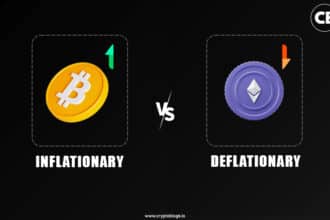Tezos, a public and open-source blockchain protocol, is gaining momentum as a platform that addresses key barriers hindering blockchain adoption for assets and applications. With a global community of developers, researchers, and validators, Tezos offers a decentralized network that enables users to directly interface, exchange value, and interact with applications without intermediaries.
This article delves into the fundamental aspects of Tezos to find out how it is competing against other cryptos traded on IMMEDIATEFUTURE IO. This article will provide detailed info on Trezos blockchain, highlighting its safety features, Self-Amendment, and unique characteristics that set it apart in the blockchain space.
What is Tezos?
Tezos is a public and open-source blockchain platform for assets and applications that can evolve by upgrading itself. The platform focuses on providing robust safety measures and ensuring Self-Amendment, both at the protocol and application layers. By enabling secure and frictionless transactions, Tezos facilitates direct peer-to-peer interactions without the need for intermediaries.
Understanding Tezos in Brief
Tezos, launched in 2014, operates as an open-source proof-of-stake (PoS) blockchain network. With its native cryptocurrency, Tez (XTZ), commonly referred to as tezzie, users can engage in peer-to-peer transactions and deploy smart contracts through the decentralized platform.
Tezos aims to revolutionize protocol development by offering new solutions to the challenges faced by existing blockchain platforms. As one of the top cryptocurrencies, Tezos continues to make its mark in the digital asset landscape.
Tezos: A Blockchain Designed to Evolve
Self-Amendment:
Tezos distinguishes itself by its inherent ability to adapt, adjust, and enhance its features and functionality through an on-chain upgrade mechanism. Unlike many other blockchain platforms, Tezos is built to evolve over time, allowing for seamless upgrades without requiring disruptive hard forks.
This evolutionary approach empowers developers to introduce new solutions and improvements to the protocol, creating a dynamic and future-proof ecosystem. By reducing coordination and execution costs, Tezos can seamlessly implement future innovations and improvements, ensuring the continuity and growth of the platform.
On-Chain Governance:
Tezos to embrace an inclusive on-chain governance mechanism where all stakeholders can actively participate in governing the protocol. Through a formal election cycle, stakeholders reach consensus on proposed protocol amendments.
This dynamic governance structure allows for the adoption of improved mechanisms as they emerge, ensuring the evolution of Tezos’ governance process over time.
Decentralized Innovation:
Tezos incentivizes the active participation of developers and stakeholders by incorporating a funding mechanism for protocol improvement proposals. Proposed amendments that are accepted by stakeholders can include payments to individuals or groups that work on the development of the protocol.
By fostering an open and diverse developer ecosystem, Tezos encourages robust participation and decentralizes the maintenance of the network.
Smart Contracts & Formal Verification:
Tezos provides a robust platform for creating smart contracts and building decentralized applications (dapps) resistant to censorship and third-party interference. Moreover, Tezos supports formal verification, a technique that mathematically proves properties about programs, including smart contracts.
By employing formal verification, Tezos minimizes the risk of costly bugs and contentious debates, enhancing the security and reliability of the platform.
Proof-of-Stake (PoS)
Tezos utilizes a proof-of-stake (PoS) consensus mechanism, where participants, known as nodes, contribute computational resources to maintain the network. Unlike other PoS protocols, Tezos enables any stakeholder to participate in the consensus process, earning rewards for enhancing the network’s security and stability.
PoS reduces costs associated with consensus mechanisms and lowers barriers to entry for involvement, fostering a more inclusive and sustainable ecosystem.
Delegation:
Tezos allows users to delegate their consensus participation rights to other trusted users if they prefer not to engage directly. Participants in the consensus process are required to make a security deposit to prevent dilution caused by inflation. Honest behavior is incentivized through rewards, while dishonest behavior is penalized by potentially losing the deposit.
Delegation offers flexibility and encourages broader stakeholder engagement within the Tezos network.
What are the advantages of Tezos over other blockchain platforms
Tezos has several advantages over other blockchain platforms, including:
- Self-amending: Tezos can upgrade itself without having to split the network into two different blockchains, unlike traditional blockchains like Ethereum, which require a hard fork to make significant changes to the protocol.
- Modular architecture: Tezos is built to remain state-of-the-art. Its modular architecture and formal upgrade mechanism minimizes disruptions while offering regular upgradability and enhanced functionality over time.
- Governance: Tezos attempts to build the decision-making process into the network of users itself, distinguishing it from other blockchain platforms. Stakeholders govern upgrades to the core protocol, including upgrades to the amendment process itself.
- Formal verification: Tezos facilitates formal verification, a technique used to improve security by mathematically proving properties about programs such as smart contracts.
What are The Use Cases of Tezos Blockchain?
Tezos is a compelling choice for developers and users seeking to leverage blockchain technology for various high-value applications, including:
- Smart Contracts:
Tezos supports smart contracts, which are self-executing agreements with predefined rules. Developers can create and deploy smart contracts on the Tezos blockchain, enabling a wide range of applications such as decentralized finance (DeFi), supply chain management, digital identity, voting systems, and more.
- Decentralized applications:
Tezos provides a platform for issuing new assets to form decentralized applications (dapps). These dApps can encompass a wide range of industries and use cases, including finance, supply chain management, identity verification, gaming, and more. Tezos’ secure and censorship-resistant nature empowers developers to build innovative and trustless applications.
- Financial applications:
Tezos aims to provide the safety and correctness required for use by financial assets. Tezos offers a platform to create smart contracts and build decentralized applications that cannot be censored or shut down by third parties.
- Cross-Chain Swaps:
Tezos supports cross-chain swaps, enabling the seamless transfer of digital assets between Tezos and other compatible blockchain networks. This interoperability opens up opportunities for liquidity, market access, and collaboration across different blockchain ecosystems, enhancing the overall flexibility and utility of Tezos.
- Interactive End-User Applications:
Tezos offers a robust infrastructure layer that empowers developers to create interactive and user-friendly applications. These applications can range from engaging games to sophisticated financial tools, virtual real estate platforms, and more.
By providing the necessary tools and resources, Tezos fosters the development of user-centric applications that enhance the overall user experience within the blockchain ecosystem.
What Is The Future Of Tezos?
The future of Tezos looks promising, with ongoing protocol upgrades, expanding use cases, scalability enhancements, increased developer adoption, interoperability efforts, and a path towards regulatory compliance and mainstream adoption.
- Continued Protocol Upgrades:
Tezos has demonstrated its ability to evolve through on-chain protocol upgrades. This self-amendment capability allows the platform to adapt to changing technological needs, regulatory requirements, and user feedback. As the Tezos community continues to propose and implement upgrades, the protocol is expected to become more robust, scalable, and feature-rich.
- Expansion of Use Cases:
Tezos is likely to witness the expansion of its use cases across various industries. The platform’s versatility makes it suitable for applications ranging from decentralized finance (DeFi) and non-fungible tokens (NFTs) to supply chain management, gaming, identity verification, and more. As developers and entrepreneurs explore the potential of Tezos, we can expect a diverse ecosystem of innovative and practical applications to emerge.
- Enhanced Scalability and Performance:
As blockchain technology advances, scalability and performance improvements are crucial for widespread adoption. Tezos is actively exploring solutions to enhance its scalability and transaction throughput. Innovations such as layer-2 scaling solutions, sharding, and off-chain protocols may be integrated into the Tezos ecosystem to address scalability challenges and ensure a seamless user experience.
- Increasing Developer Adoption:
Tezos is focused on fostering an active and diverse developer ecosystem. The platform offers developer-friendly tools, resources, and incentives to encourage the creation of decentralized applications (dApps) and smart contracts. As more developers recognize the advantages of Tezos, we can anticipate an increase in the number and quality of projects built on the platform, driving further adoption and innovation.
- Interoperability and Cross-Chain Collaboration:
Interoperability between different blockchain networks is becoming crucial for unlocking the full potential of decentralized applications. Tezos is likely to explore interoperability solutions that enable seamless interaction and asset transfers between Tezos and other blockchain platforms. Cross-chain collaboration can enhance liquidity, expand market access, and facilitate the exchange of assets and data, opening up new possibilities for the Tezos ecosystem.
- Regulatory Compliance and Mainstream Adoption:
With the increasing adoption of blockchain technology, regulatory frameworks are evolving to accommodate digital assets and decentralized applications. Tezos’ focus on safety, code correctness, and on-chain governance positions it favorably for compliance with regulatory requirements. As the regulatory landscape matures, Tezos is well-positioned to attract institutional investors, traditional financial institutions, and enterprises looking to leverage blockchain technology.
These factors collectively contribute to the growth and maturation of the Tezos ecosystem as it continues to establish itself as a prominent blockchain platform.
Also Read: How to Buy NFT on Tezos Blockchain
In Conclusion:
Tezos is a blockchain platform that stands out for its self-amendment capability, on-chain governance, formal verification, and focus on security. It offers a flexible and inclusive environment for developers and users to build and deploy decentralized applications, smart contracts, and digital assets.
With its unique features and use cases spanning various industries, Tezos aims to drive blockchain adoption and innovation while providing a secure and scalable infrastructure for the future of decentralized technologies.







